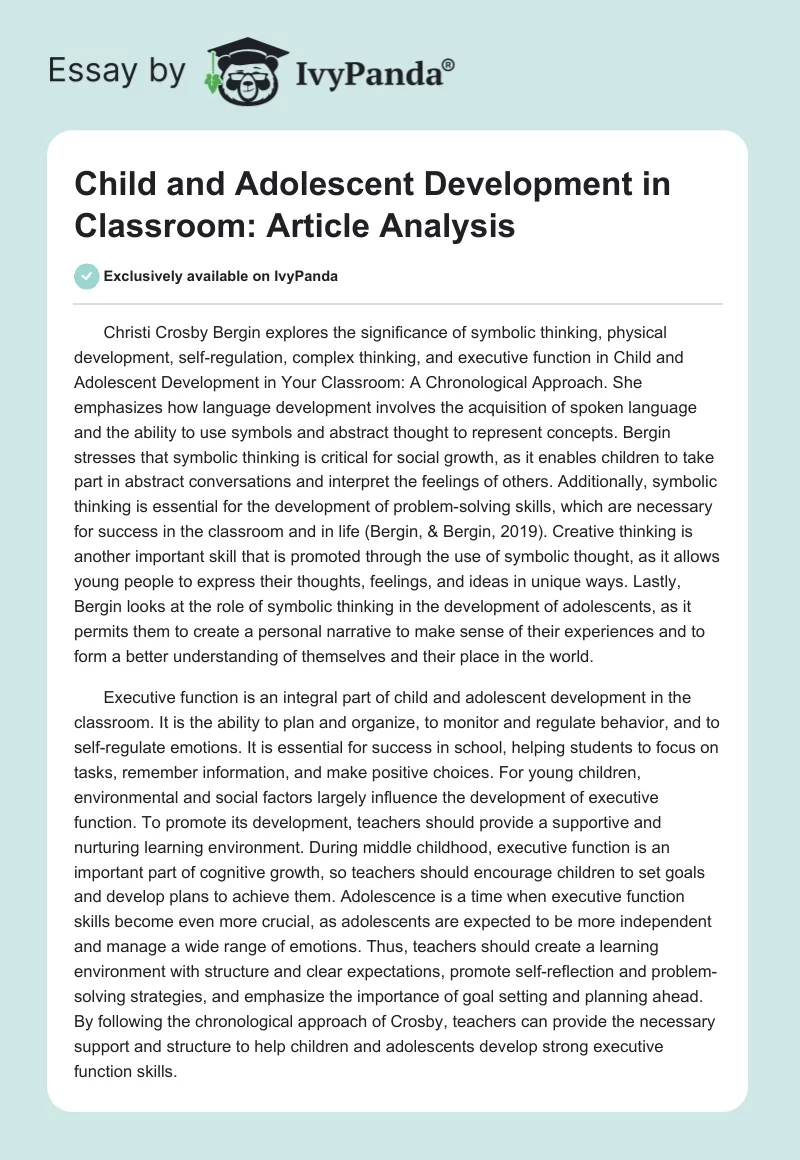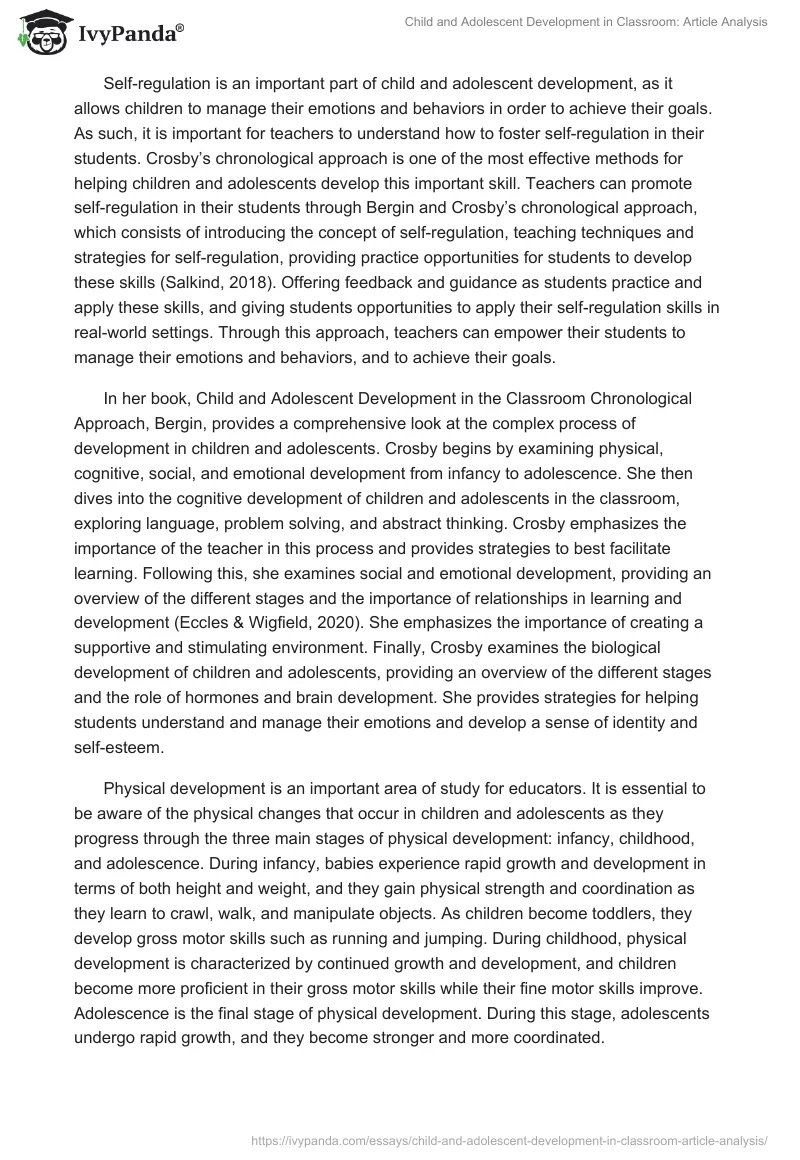Christi Crosby Bergin explores the significance of symbolic thinking, physical development, self-regulation, complex thinking, and executive function in Child and Adolescent Development in Your Classroom: A Chronological Approach. She emphasizes how language development involves the acquisition of spoken language and the ability to use symbols and abstract thought to represent concepts. Bergin stresses that symbolic thinking is critical for social growth, as it enables children to take part in abstract conversations and interpret the feelings of others. Additionally, symbolic thinking is essential for the development of problem-solving skills, which are necessary for success in the classroom and in life (Bergin, & Bergin, 2019). Creative thinking is another important skill that is promoted through the use of symbolic thought, as it allows young people to express their thoughts, feelings, and ideas in unique ways. Lastly, Bergin looks at the role of symbolic thinking in the development of adolescents, as it permits them to create a personal narrative to make sense of their experiences and to form a better understanding of themselves and their place in the world.
Executive function is an integral part of child and adolescent development in the classroom. It is the ability to plan and organize, to monitor and regulate behavior, and to self-regulate emotions. It is essential for success in school, helping students to focus on tasks, remember information, and make positive choices. For young children, environmental and social factors largely influence the development of executive function. To promote its development, teachers should provide a supportive and nurturing learning environment. During middle childhood, executive function is an important part of cognitive growth, so teachers should encourage children to set goals and develop plans to achieve them. Adolescence is a time when executive function skills become even more crucial, as adolescents are expected to be more independent and manage a wide range of emotions. Thus, teachers should create a learning environment with structure and clear expectations, promote self-reflection and problem-solving strategies, and emphasize the importance of goal setting and planning ahead. By following the chronological approach of Crosby, teachers can provide the necessary support and structure to help children and adolescents develop strong executive function skills.
Self-regulation is an important part of child and adolescent development, as it allows children to manage their emotions and behaviors in order to achieve their goals. As such, it is important for teachers to understand how to foster self-regulation in their students. Crosby’s chronological approach is one of the most effective methods for helping children and adolescents develop this important skill. Teachers can promote self-regulation in their students through Bergin and Crosby’s chronological approach, which consists of introducing the concept of self-regulation, teaching techniques and strategies for self-regulation, providing practice opportunities for students to develop these skills (Salkind, 2018). Offering feedback and guidance as students practice and apply these skills, and giving students opportunities to apply their self-regulation skills in real-world settings. Through this approach, teachers can empower their students to manage their emotions and behaviors, and to achieve their goals.
In her book, Child and Adolescent Development in the Classroom Chronological Approach, Bergin, provides a comprehensive look at the complex process of development in children and adolescents. Crosby begins by examining physical, cognitive, social, and emotional development from infancy to adolescence. She then dives into the cognitive development of children and adolescents in the classroom, exploring language, problem solving, and abstract thinking. Crosby emphasizes the importance of the teacher in this process and provides strategies to best facilitate learning. Following this, she examines social and emotional development, providing an overview of the different stages and the importance of relationships in learning and development (Eccles & Wigfield, 2020). She emphasizes the importance of creating a supportive and stimulating environment. Finally, Crosby examines the biological development of children and adolescents, providing an overview of the different stages and the role of hormones and brain development. She provides strategies for helping students understand and manage their emotions and develop a sense of identity and self-esteem.
Physical development is an important area of study for educators. It is essential to be aware of the physical changes that occur in children and adolescents as they progress through the three main stages of physical development: infancy, childhood, and adolescence. During infancy, babies experience rapid growth and development in terms of both height and weight, and they gain physical strength and coordination as they learn to crawl, walk, and manipulate objects. As children become toddlers, they develop gross motor skills such as running and jumping. During childhood, physical development is characterized by continued growth and development, and children become more proficient in their gross motor skills while their fine motor skills improve. Adolescence is the final stage of physical development. During this stage, adolescents undergo rapid growth, and they become stronger and more coordinated.
Additionally, puberty occurs during adolescence, which includes the development of secondary sexual characteristics and the development of reproductive organs. In such a classroom, it is advisable to use chronological approach to physical development in child and adolescent development. This way, teachers’ help their students understand the physical changes that occur as they grow, either by use of videos, books, and hands-on activities. Through these activities, teachers can educate their students about physical development, enabling them to understand the physical changes that happen throughout each stage of development.
References
Bergin, C. C., & Bergin, D. A. (2019). Child and adolescent development in your classroom, chronological approach. Cengage Learning.
Eccles, J. S., & Wigfield, A. (2020). From expectancy-value theory to situated expectancy-value theory: A developmental, social cognitive, and sociocultural perspective on motivation. Contemporary educational psychology, 61, 101859. Web.
Salkind, N. J. (2018). Child development. Macmillan Reference.


